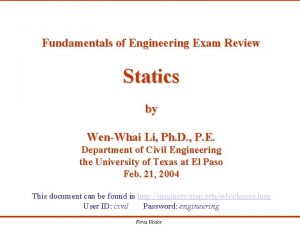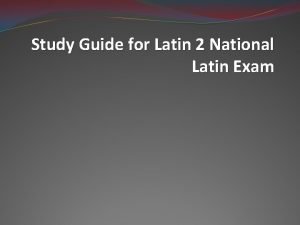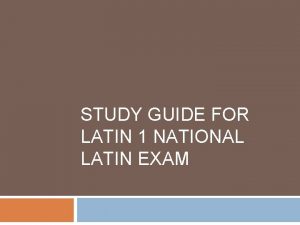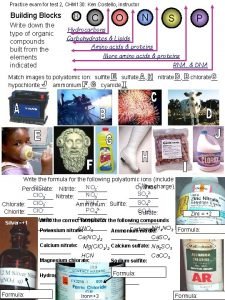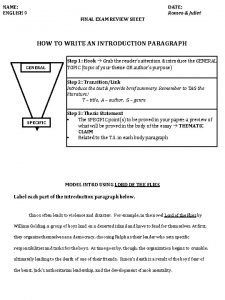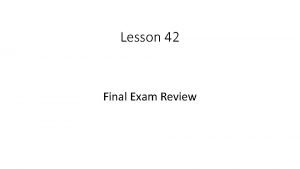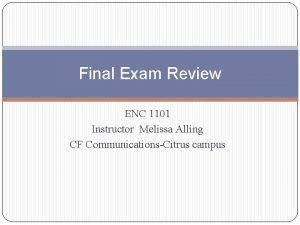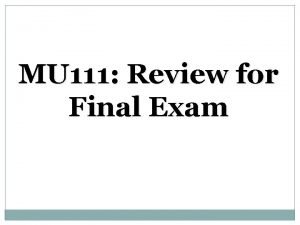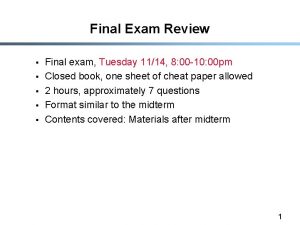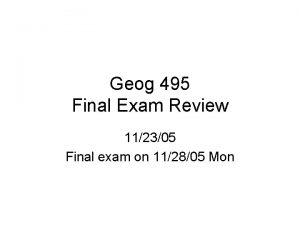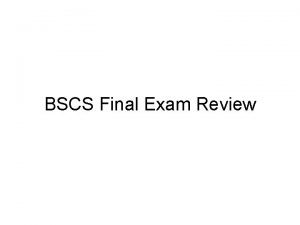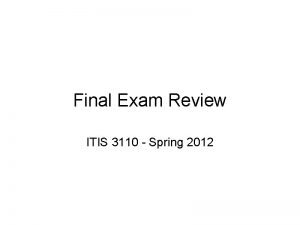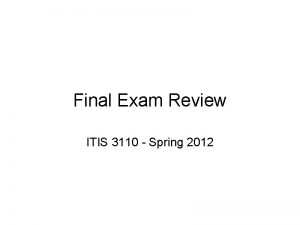SPRING FINAL EXAM REVIEW 1 Define the following













































- Slides: 45

SPRING FINAL EXAM REVIEW

1. Define the following terms: a. Force- Any push or pull on an object b. Net Force- The sum of forces acting on an object c. Friction- A force that act in the opposite direction of a force (e. g. air resistance) d. Average speed- The total distance divided by the total time

e. Instantaneous speed- The speed you are traveling at that moment (instant). E. g. car speedometer f. Acceleration- a change in velocity over time g. Vector- a quantity that has both magnitude and direction. Described using an arrow. h. Terminal velocity- The maximum velocity a falling object can obtain. When Force of gravity and air resistance forces are equal and opposite in direction.


m. Transverse wave- a wave vibrating at right angles to the direction of its propagation. (e. g. electromagnetic waves) n. Longitudinal wave- a wave vibrating in the direction of propagation. (e. g. sound waves)

o. Doppler Effect- an increase (or decrease) in the frequency of sound, light, or other waves as the source and observer move toward (or away from) each other. p. Mass- the quantity of matter in a body regardless of its volume or of any forces acting on it. (mass is not the same as weight) measured in kilograms (kg)

q. Weight (force of gravity) r. Equilibrium- If the size and direction of the forces acting on an object are exactly balanced, then there is no net force acting on it FN = 0 Newtons

1. What are the units for the following? a. Force- Newtons (N) b. Speed and velocity- Meters/second (m/s) c. Distance- Meters (m) d. Time- Seconds (s) e. Acceleration- Meters/seconds squared (m/s 2)

f. Mass- Kilograms (kg) g. Weight (Force of gravity)- Newtons (N) h. Momentum- Kilograms X meters per seconds (kg × m/s) i. Kinetic energy- Joules (J) j. Potential energy- Joules (J) k. Work- Joules (J) l. Current-Amperes (amps) (A)


PART 3: PHYSICS CONCEPTS 1. Identify two situations in which an object can have a net force = 0 Newtons. Draw the Free Body Diagrams that go with both scenarios. A falling object whose Force of gravity is equal to the air resistance force An object at rest on a table +10 N -10 N +10 N FN = 0 N -10 N

2. What is meant by “free fall”? A falling object where the only force acting on it is gravity (we assume there is no air resistance)

3. Which of the following will remain constant when an object is falling and there is no air resistance? (circle all that apply) • Velocity • Speed • Acceleration Both speed and velocity increase as an object falls

4. Explain what happens to both the kinetic and potential energies of an object when it is falling. PE = 5000 J KE = 0 J It always totals 5000 J (The Law of Conservation of Energy PE = 1000 J KE = 4000 J PE = 0 J KE = 5000 J

5. Forces always occur in pairs. 6. An object will accelerate when it is affected by unbalanced net force. 7. In the absence of air resistance, the angle at which a thrown ball will go the farthest is 45°. 8. When an object reaches terminal velocity its acceleration equals zero. 9. All waves are created by vibrations. 10. In circuits of metal wires, electrons are the flowing charged particles.

12. Any path along which electrons can flow is called a electrical circuit. 13. In most waves, the speed of the wave only depends on the waves medium. 14. What is the “Law of Conservation of Energy”? Energy can neither be created nor destroyed; rather, it can only be transformed from one form to another.

15. Friction is a force that always acts opposite to an object's motion. 16. A ball is thrown straight upward at 5 m/s. Ideally (no air resistance), the ball will return to the thrower's hand with a speed of 5 m/s. 17. If a freely falling object were somehow equipped with a speedometer, its speed reading would increase each second by 10 m/s. 18. Touching a charged body to earth to eliminate excess charge is called grounding.



24. Is it better to wire holiday lights in parallel or series? Why? Parallel. Because if one light burns out in a series circuit all of the bulbs go out. 25. When talking about sound waves, what mean the same as frequency and amplitude? Frequency = pitch Amplitude= loudness 26. Describe a scenario when an object has constant speed but not constant velocity. A car driving at a constant speed in a circle (velocity is a vector quantity)

PART 4: WORD PROBLEMS: 1. A 40 -N falling object encounters 5 -N of air resistance. The magnitude of the net force on the object is? (Draw a diagram and use vectors to answer) 40 N 5 N Fn = 35 N If vectors are in opposite direction: subtract If vectors in same direction: add

2. A bike travels at a constant speed of 20 m/s for 2 seconds. How far did it travel? v = 20 m/s t = 2 s d= ?

3. A bike travels at a constant speed of 100 meters in 10 seconds. What was the average speed? t = 10 s d = 100 m v = ?

4. How much time will it take for a person to walk 400 meters at a constant speed of 5 m/s? t = ? d = 400 m v = 5 m/s

5. You drop a rock off of a tall building. It hits the ground in 3. 0 seconds. What is the final velocity? t = 3. 0 s g = 10 m/s 2 v = ? V 0 = m/s

6. A ball is dropped from rest from a height 25. 0 meters above the ground. The ball falls freely and reaches the ground 4. 0 seconds later. What is the average speed of the ball t = 4 s d = 25 m v = ?

7. You drop a rock off of the top of a 50 m tall building. How long does it take before it hits the ground? t = ? d = 50 m g = 10 m/s 2

8. The figure shows a block that is being pulled along the floor. According to the figure, what is the acceleration of the block? m = 20 kg FN = 100 N a = ?

9. Suppose a small plane can fly at 200 km/h relative to the surrounding air. Suppose also that there is a 50 km/h tailwind. How fast does the plane's shadow move across the ground? (draw vectors to solve) 50 km/h 200 km/h 250 km/h If vectors in same direction: add If vectors are in opposite direction: subtract

10. A car travels 5 meters in the first second of travel, 5 meters again during the second of travel, and 5 meters again during the third second. Its acceleration is? d = 5 m t = 1 s a = ? v = 5 m/s Velocity does not change over time: • Velocity 1 st second = 5 m/s • Velocity 2 nd second = 5 m/s • Velocity 3 rd second = 5 m/s

11. You drop a rock off of a tall building. It takes 10 seconds to hit the ground. How tall is the building? t = 10 s d = ? g = 10 m/s 2

12. A truck has a mass of 1000 kg and accelerates at 2 meters per second squared. What is the magnitude of the force acting on the truck? m = 1000 kg a = 2 m/s 2 F = ?

13. A tow truck exerts a force of 2000 N on a car, accelerating it a 1 m/s 2. What is the mass of the car? m = ? a = 1 m/s 2 F = 2000 N

14. A hydraulic lift used at an automotive repair shop raises a 500 -kilogram car 3 meters off of the ground. What is the potential energy given to the car? m = 500 kg h = 3 m PE = ?

15. A 3 -kg brick falls to the ground from a 10 -m-high roof. What is the approximate kinetic energy of the brick just before it touches the ground? m = 3 kg h = 10 m KE = ? When the object falls the potential energy is transformed into kinetic energy

16. What is the kinetic energy of a wagon with a mass of 2. 5 kilograms traveling at a speed of 4 meters per second? Assume no other forces act upon the object. m = 2. 5 kg v = 4 m/s KE = ?

17. A sound wave traveling through a solid material has a frequency of 450 hertz. The wavelength of the sound wave is 1 meters. What is the speed of sound in the material? f = 450 Hz Ƴ = 1 m v = ?

18. If 15 N of force are applies to a cart to move it a distance of 5 m, how much work is done on the cart? F = 15 N d = 5 m W = ?

19. A sound wave has a frequency of 250 Hz and a wavelength measured at 2. 00 m. What is the speed of the wave? f = 250 Hz Ƴ = 2 m v = ?

20. An object has an initial Gravitational Potential Energy of 5000 J and its initial Kinetic Energy is 0 J. If it’s Gravitational Potential Energy after is 1000 J, what is its Kinetic Energy after? PE = 5000 J KE = 0 J It always totals 5000 J (The Law of Conservation of Energy PE = 1000 J KE = 4000 J PE = 0 J KE = 5000 J

21. A child is on a sled moving down a hill at 15. 0 m/s. The combined mass of the sled and child is 50. 0 kilograms. The momentum of the child and sled is? v = 15 m/s m = 50. 0 kg p = ?

22. A 100 -watt light bulb is connected to a 120 -V outlet. How much current is in the light bulb? P = 100 W V = 120 V I = ?

23. How much power is used by a 12 Volt battery that draws 2 A of current? P = ? V = 12 V I = 2 A

24. When a 12 -V battery is connected to a resistor, 0. 5 A of current flows in the resistor. What is the resistor's value? R = ? V = 12 V I = 0. 5 A

25. A 20 -ohm resistor has a 5 -A current in it. What is the voltage across the resistor? R = 20Ω I = 5 A V = ?
 World history spring final exam review answers
World history spring final exam review answers Writ of certiorari ap gov example
Writ of certiorari ap gov example World geography spring final review
World geography spring final review Spanish 1 answers
Spanish 1 answers Pltw human body systems final exam review
Pltw human body systems final exam review Truss practice problems poe
Truss practice problems poe Ied final exam
Ied final exam World history regular semester 1 review
World history regular semester 1 review Principles of business final exam answer key
Principles of business final exam answer key Spanish 2 final exam review packet
Spanish 2 final exam review packet Environmental science final
Environmental science final Ap world history jeopardy review game
Ap world history jeopardy review game Us history final semester 2 review
Us history final semester 2 review English 2 semester exam
English 2 semester exam Physics 20 final exam practice
Physics 20 final exam practice Physical science jeopardy
Physical science jeopardy Mat 1033 final exam answers
Mat 1033 final exam answers Statics final exam review
Statics final exam review Zoology final exam review
Zoology final exam review Earth science final exam review
Earth science final exam review Final exam review algebra 1
Final exam review algebra 1 Accounting final exam review
Accounting final exam review Personal finance final exam review
Personal finance final exam review Spanish 1 final review
Spanish 1 final review Psychology final exam review
Psychology final exam review Bae yong-kyun
Bae yong-kyun Winter spring summer or fall
Winter spring summer or fall Web design final exam
Web design final exam Us history final exam study guide semester 2
Us history final exam study guide semester 2 Sbu final exam schedule
Sbu final exam schedule Latin 2 final exam answers
Latin 2 final exam answers National latin exam practice
National latin exam practice Street law final exam
Street law final exam Pointing
Pointing Realidades 2 final exam
Realidades 2 final exam Chemistry 151 final exam
Chemistry 151 final exam Chm 130 chapter 12 practice problems answer key
Chm 130 chapter 12 practice problems answer key Romeo and juliet exam review
Romeo and juliet exam review 42 final exam
42 final exam I am not contraction
I am not contraction Hrm final exam
Hrm final exam Hospitality and tourism final exam
Hospitality and tourism final exam Hbs eoc practice test
Hbs eoc practice test Animal science final exam
Animal science final exam Enc 1101 final exam
Enc 1101 final exam Ferpa safe schools answers
Ferpa safe schools answers

















